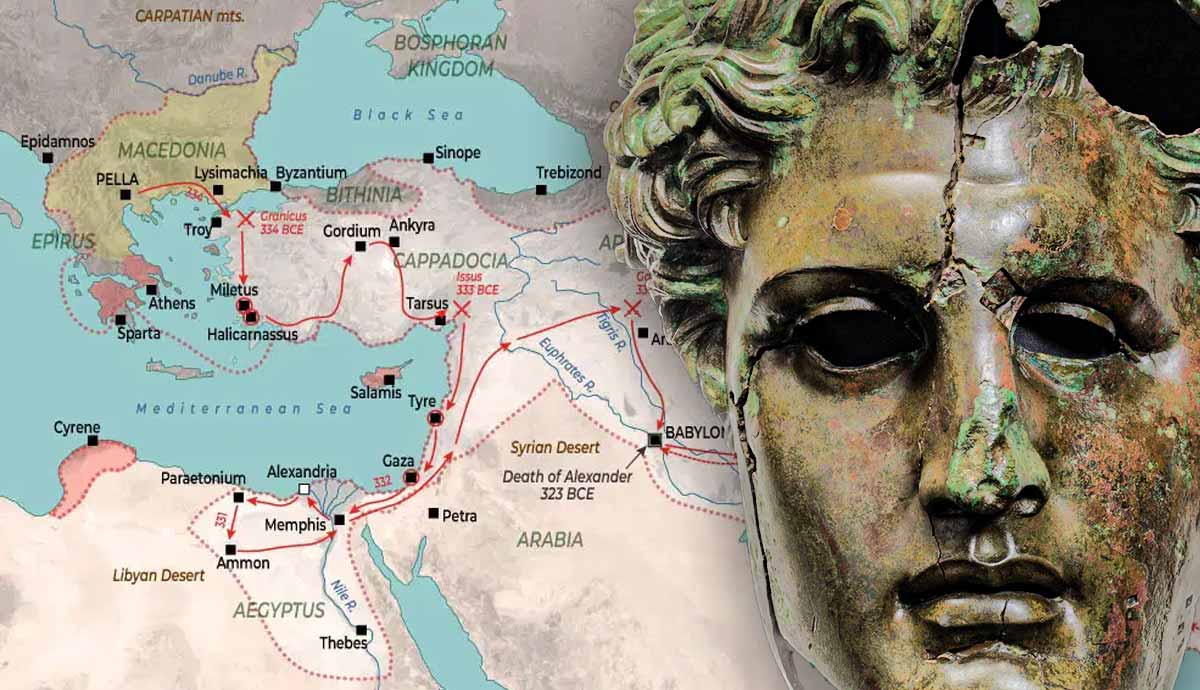
For much of prehistory, humans were primarily hunters and gatherers. Around 10,000-9000 BCE, a shift began with the domestication of plants and animals, leading to planned agriculture, food surpluses, and permanent settlements, termed the “Neolithic revolution”. However, these changes were gradual, spanning thousands of years, with no sudden abandonment of previous lifestyles. Thus, calling it a “revolution” may not be entirely accurate.
Did the Neolithic Revolution Spread From One Area?

The earliest signs of the Neolithic period appeared in the so-called “Fertile Crescent”, a region in southwestern Asia spanning from the western Mediterranean to the Persian Gulf. It is usually assumed that the domestication of the first plants and animals spread from this area following contacts between groups, first in neighboring areas and later throughout Asia to Europe and northern Africa. However, it is equally possible that these changes appeared independently and not due to contacts or cultural influences. For example, in the Americas, agriculture developed independently around 8000 BCE. There are also strong indicators of independent development in Africa.
Various theories surround the emergence of planned food production, with many suggesting that environmental changes, possibly a reduction in available resources, prompted populations to adapt and seek new ways to acquire food. A combination of factors likely contributed to these significant transformations of prehistoric communities over time.

The Neolithic period is known as a time of changes that gradually transformed prehistoric societies. From hunter-gatherers, these communities switched to producing their own food: growing crops and other plants and domesticating animals for meat and dairy. In turn, farming required a sedentary lifestyle, so people started building permanent settlements and the first cities. These changes are typically listed as the most important contributions of what is known as the Neolithic Revolution.
How Sudden Were the Changes?

While the development of agriculture, plant and animal domestication, and permanent settlements are well-confirmed, these were gradual changes that did not necessarily lead to the immediate abandonment of older practices.
The term “Neolithic Revolution” suggests a sudden and radical transformation in human lifestyles and economies. But as far as we know, this is not what happened. On the contrary, it was a long process that started well before 10,000 BCE.
The idea of the Neolithic Revolution was popularized in the early 20th century. The terms “Palaeolithic” (Old Stone Age) and “Neolithic” (New Stone Age) were first introduced by Sir John Lubbock during the mid-19th century. Later, Vere Gordon Childe coined the phrase “Neolithic Revolution” in the 1930s to describe significant transformations of the human prehistorical communities. According to this explanation, the revolution was sparked by the invention of agriculture, marked notably by the transition from traditional food foraging (hunting and gathering) to food production through plant and animal domestication. This significant change prompted a shift from nomadic ways of life to permanent settlements.
This view assumes profound, sudden, and complete cultural changes in subsistence strategies, settlement patterns, technology, and lifestyle. Today, researchers agree that there are better ways to describe Neolithic transformations. Rather than a uniform and sudden upheaval, the transition from hunting and gathering to agriculture was marked by gradualism, regional variation, and the persistence of earlier practices.
Domestication

One of the key components of Neolithic changes was plant and animal domestication. This, too, was a gradual process that lasted for thousands of years. Animal domestication began well before the Neolithic times, with the domestication of the wolf about 20,000 years ago. Later, humans began domesticating other wild animals, such as cattle, pigs, sheep, and goats. These changes occurred only after plant domestication was well underway.
It is most probable that plant domestication began by stockpiling suitable plants for consumption. Wheat, barley, rice, and corn were among the first domesticated plants, evolving significantly from their wild counterparts. Hunter-gatherers collected favorable plant foods and encouraged certain wild plants to grow. They progressively cultivated these plants and selected those with desirable traits. Over time, humans developed farming techniques, including irrigation and crop rotation. Perfecting these techniques took time and, we assume, a lot of trial and error over generations.
Other Neolithic Changes

The Neolithic period saw people transitioning from nomadic hunting and gathering to settled agricultural lifestyles. This introduced major demographic changes, allowing for larger populations, more children, and the emergence of surplus food and resources. However, research shows that the population increase and other demographic changes occurred gradually, and not always in the same way across societies. For example, some societies saw a population decline during early Neolithic times.
As food surplus increased, it gave rise to new forms of settlements and intricate social and political systems. Early Neolithic sites, such as Jericho and Catal Huyuk offer insights into the transition from nomadic lifestyles to settled farming communities. This era marked the emergence of more complex societies, driven by advancements in agriculture and, later, metalworking. The settlements with surplus agricultural products and thriving trade networks eventually gave rise to great civilizations in regions like Egypt, Mesopotamia, China, and India.

Another significant Neolithic change was the invention of pottery. Large quantities of grain needed suitable vessels for storing, which prompted people to shape clay and other materials, leading to the development of pottery. However, it is not correct to simply link pottery with any sudden change — it was also a gradual process that began before Neolithic times.
For example, some hunting and gathering groups developed pottery around 20,000 years ago, possibly earlier. On the other hand, many Neolithic cultures only adopted pottery much later, often after already adopting agriculture and permanent settlements. It is not surprising that pottery enjoyed a “boom” during the Neolithic times: large clay vessels were great for storing and transporting grains, as well as for food preparation.
Pottery is considered an important aspect of Neolithic communities. However, it was invented by Neolithic societies. Like many other changes, pottery first appeared well before the major Neolithic developments. It is yet another indication that the Neolithic Revolution was a gradual process and not a rapid revolution. Also, while many agricultural communities used pottery, not every Neolithic community adopted it.
The Neolithic times also brought challenges, including increased disease prevalence compared to hunter-gatherer communities and less free time due to labor-intensive farming and animal husbandry. While agriculture provided a more stable food supply, it also led to changes in diet and living conditions. These changes had both positive and negative effects on health, including the emergence of new diseases.
Regional Differences

Another problem with the idea of the Neolithic Revolution as a widespread, sudden change is that different places adopted these transformations in their own way. Agriculture was developed or adopted at different periods throughout the world. The “standard” set of Neolithic changes — agriculture, domestication, sedentarism, and pottery — was not present in all societies. Many cultures adopted a “hybrid” set of practices, combining old and new ways. For many communities, it meant farming in addition to hunting and gathering. Also, it has been proved that farming and agriculture do not necessarily lead to the development of permanent settlements and sedentarism — some groups remained nomadic.
Each geographical area had its own unique challenges and opportunities, resulting in distinct pathways to settled agriculture. The process of domesticating plants and animals, for example, varied significantly between the Fertile Crescent, East Asia, and the Americas. Also, many hunter-gatherer groups in various parts of the world continued their traditional practices while interacting with agricultural neighbors.
Climate and the availability of specific wild plant and animal species dictated what could be domesticated successfully. Different groups found their own way of approaching farming, as well as the organization of collecting, storing, and distributing food between family members and the larger society. The diversity in practices and timelines contradicts the notion of a universal “revolution” that transformed societies in very specific ways.
Rethinking Neolithic Transformations

The Neolithic period is known for its important changes in subsistence strategies and settlement patterns. It is, without a doubt, a period of cultural and technological milestones that still affects the world today. Agriculture (as the opposite of hunting and gathering) became a dominant approach for most societies in the world, and communities rarely chose to switch back to hunter-gatherer subsistence. Other changes, such as sedentarism and the rise of cities, were also important and historically significant.
However, it would be misleading to talk about a sudden change or a radical change that put a stop to old practices. Neolithic transformations were a gradual process that different societies adopted at different points and in their own way. For many communities, the shift to agriculture did not mean a complete abandonment of hunting and gathering but a complementary strategy. It is important to recognize that many societies maintained elements of their previous lifestyle, blending both new and old practices. This gradualism and the continuity of certain traditions undermine the idea of a revolutionary break.
Instead of a revolution — a sudden, widespread change that led to the abandonment of old practices — the Neolithic transformations should be understood as gradual changes with numerous regional specificities. These changes began before the Neolithic period (10,000-9000 BCE in the Fertile Crescent) and were often combined with older strategies. Even if groups abandoned hunting and gathering or nomadic lifestyle at one point, it is not always accurate to explain it as a simple “switch” to Neolithic practices.










